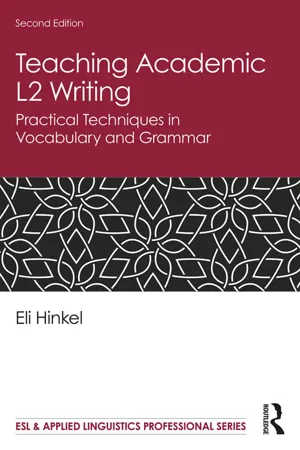
- 484 pages
- English
- ePUB (mobile friendly)
- Available on iOS & Android
About This Book
The new edition of this comprehensive text fills an important role in teacher professional preparation by focusing on how to teach the grammar and vocabulary that are essential for all L2 writing teachers and student-writers. Before L2 writers can begin to successfully produce academic prose, they need to understand the foundations of the language and develop the language tools that will help them build reasonable quality text. Targeting specific problem areas of students' writing, this text offers a wealth of techniques for teaching writing, grammar, and vocabulary to second-language learners.
Updated with current research and recent corpus analysis findings, the second edition features a wealth of new materials, including new teaching activities; student exercises and assignments; and substantially revised appendices with supplementary word and phrase lists and sentence components. Designed for preservice ESL/ELT/TESOL courses as well as Academic Writing and Applied Linguistics courses, this book includes new, contextualized examples in a more accessible and easy-to-digest format.
Frequently asked questions
Information
Part I
Academic Text and Teaching Second Language Writing
- Learning to write in a L2 is different from learning to write in a first language (LI).
- Teaching L2 writing the way LI writing is taught is not effective.
- The knowledge-transforming type of writing expected in academic disciplines is different from personal experience narratives or conversational discourse.
- Academic language, that is, vocabulary, grammar, and discourse, cannot be developed through conversational or interactional activities - whether written or spoken. Academic language does not occur in conversations.
- Extensive, thorough, and focused instruction in L2 academic vocabulary, grammar, and discourse is essential for developing L2 written proficiency.
- Writing requirements in a university.
- Characteristics of academic writing and academic text.
- Common writing tasks students will need to perform in their college and university studies in particular disciplines.
1
The Importance of Text in Academic Writing
Overview
- L2 writers and academic writing skills in English.
- Principles and foundations for learning to write L2 academic prose.
- Academic writing.
- Academic vocabulary and grammar.
Student Enrollments
- Taken together, international and immigrant students represent about 25% to 30% of college and university enrollments in the US.
- Furthermore, although these figures fluctuate widely by location, 24% of the current students in public schools are immigrants and children of recent immigrants, and most plan to continue their education in US colleges and universities (Camarota, Griffith, & Zeigler, 2017).
Academic Writing Skills in English
- The process-centered instructional methodology for teaching writing focuses on invention, creating ideas, and discovering the purpose of writing.
- Within the process-centered paradigm for teaching L2 writing, student writing is evaluated on the quality of pre-writing, writing, and revision.
- Because the product of writing is seen as secondary to the writing process, and even inhibitory in the early stages of writing, issues of L2 grammar, vocabulary, and errors, are to be addressed only as needed in particular contexts.
- In process-centered instruction, there is a generally held belief that L2 writers with proficiency levels higher than beginner learn from being exposed to L2 text and discourse - while reading and writing - and thus acquire L2 grammar and vocabulary naturally.
- Outside L2 writing and English composition courses, evaluations of L2 writing skills in the disciplines and general education courses has continued to focus on the product, rather than the process, of writing.
- In academic courses such as history, sociology, business, or the natural sciences at both the undergraduate and graduate levels, evaluations of L2 students" academic skills are determined by their performance on traditional product-oriented language tasks, most frequently reading and writing.
Principles and Foundations
Table of contents
- Cover
- Half Title
- Title Page
- Copyright Page
- Contents
- Preface
- Acknowledgements
- Part I Academic Text and Teaching Second Language Writing
- Part II Sentences and Their Parts: Vocabulary and Grammar
- Part III Text and Discourse Organization: The Sentence and Beyond
- Appendix A: Formulaic Expressions, Sentence Stems, and Phrases for Speaking, Presenting, and Participating in Meetings
- Appendix Β: Constructions, Formulaic Sequences, and Sentence Stems for Academic Writing
- Index